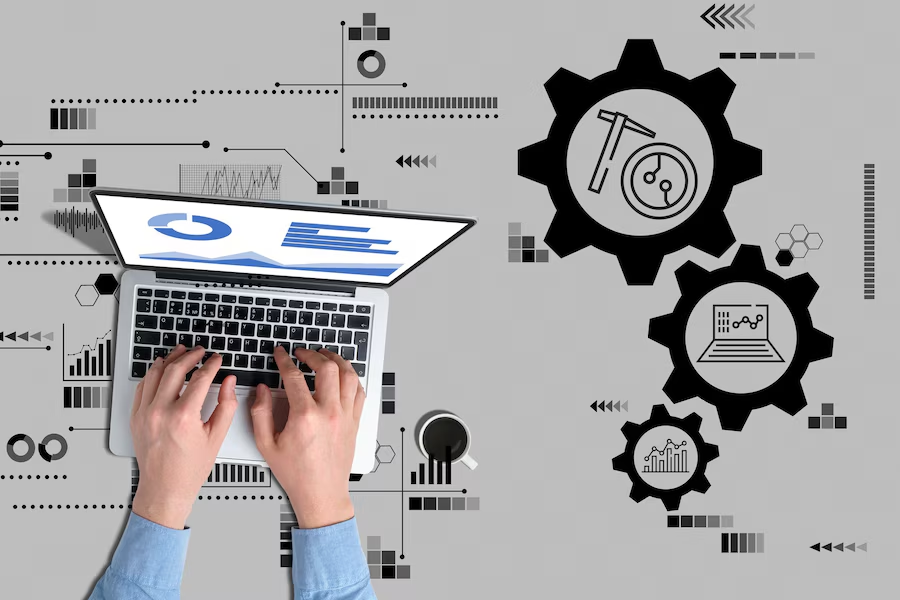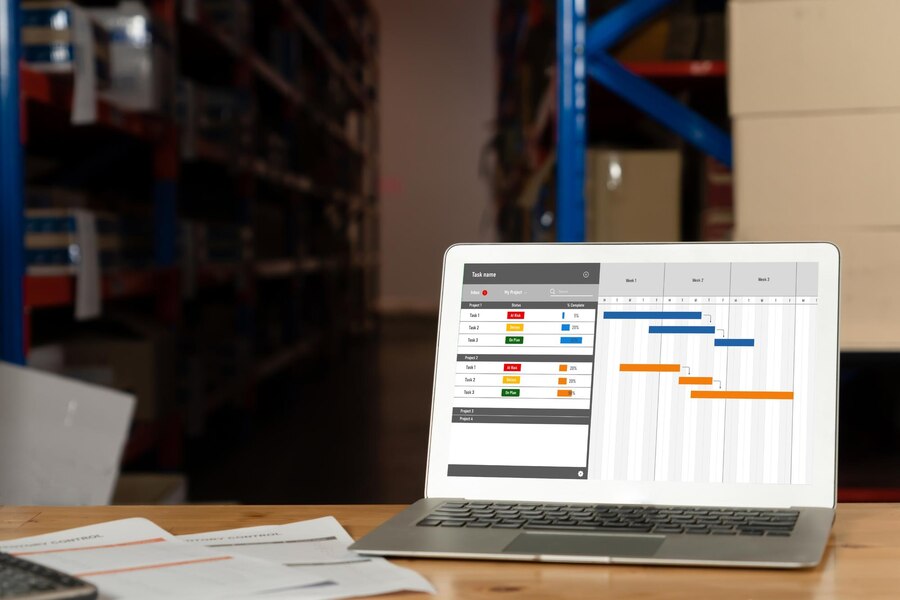- February 19, 2025
- by Tech Delivery Partners
Program Management Tools And Techniques [2025]
Managing programs isn’t just about ticking off tasks on a checklist but balancing multiple moving parts. No matter what, if you oversee a company-wide transformation or coordinate several related projects. The right tools and techniques can make all the difference.
Let’s see what program management is all about and explore some tools and techniques to keep your programs on track.
Must-Have Tools for Program Management
Let’s face it: you can’t manage a program with sticky notes and spreadsheets alone. Here are some tools to supercharge your efforts:
Planning Tools
Planning is the most tricky yet important part of the management. You can say this is the pillar of the whole project. So you need to do it correctly. What if I say there are tools to help you out and make your work easy?
Sound revealing? Let’s see,
1. Gantt Charts
Gantt charts are like the timeline of your dreams. They let you see all your tasks laid out visually, complete with start dates, end dates, and dependencies. It’s perfect for spotting overlaps or bottlenecks before they cause delays. Tools like Microsoft Project or Smartsheet make building and updating Gantt charts easy.
So you always know what’s coming next. If you’re managing a big program with lots of moving parts, a Gantt chart will be your best friend.
How They Help:
- Provide a clear visual timeline of tasks and milestones.
- Highlight dependencies between tasks, so you can avoid bottlenecks.
- Allow easy updates and tracking of progress.
2. Kanban Boards
If you’re more into flexible planning, Kanban boards are a lifesaver. They let you organize tasks into columns, like “To Do,” “In Progress,” and “Done,” so you can see the workflow at a glance.
Trello and Jira are popular choices for Kanban boards and are super intuitive. Drag and drop your tasks as they progress; managing work suddenly feels less overwhelming. These are especially great for teams juggling multiple priorities.
How They Help:
- Enable teams to focus on completing tasks one at a time.
- Make it easy to identify bottlenecks in the workflow.
- Support collaboration with real-time updates.

3. Work Breakdown Structure (WBS) Tools
Sometimes, breaking things down into smaller pieces is the only way to tackle big projects. Work Breakdown Structure (WBS) tools help you organize your program into manageable chunks so nothing slips through the cracks. Lucidchart and Wrike are great options for this.
With WBS tools, you can visually map out every step of your program, assign tasks to the right people, and ensure no one is overburdened. It’s like creating a game plan before the big match.
How They Help:
- Break complex programs into bite-sized tasks.
- Assign responsibilities clearly.
- Link deliverables to program objectives for better alignment.
4. Roadmapping Tools
Road mapping tools are like a GPS for your program. They help you lay out the big picture, showing milestones and key goals over time.
Aha! and Monday.com are great tools that make road mapping easy. They’re perfect for high-level planning and showing stakeholders what’s ahead.
If you’ve got a long-term program that needs regular check-ins and updates, a roadmap will keep everyone aligned and on track.
How They Help:
- Align teams around shared objectives.
- Showcase milestones and deliverables in an easy-to-read format.
- Keep stakeholders informed and engaged
5. Critical Path Method (CPM) Tools
Now, there is no correct answer to this. It depends on your skill level. But still, here is an idea-
The Critical Path Method is about figuring out which tasks can’t be delayed without affecting your timeline. CPM tools like Primavera P6 or Microsoft Project can automate this process.
Highlighting critical tasks so you can prioritize them. These tools are a must-have for complex programs where deadlines are tight and every day counts. They give you a clear focus and help you allocate resources where they’re needed most.
How They Help:
- Identify critical and non-critical tasks.
- Optimize schedules to reduce delays.
- Provide insights for better resource allocation.
Collaboration Tools
Collaboration tools are the glue that keeps teams connected, especially when you’re managing large programs or working with distributed teams. Here are a few tools that help a lot.
1. Slack
Slack isn’t just a chat tool; it’s a communication hub. You can keep conversations organized and reduce email overload with channels for different projects or teams. What makes Slack unique is its integration capabilities.
You can connect it to tools like Google Drive, Trello, and even automation apps like Zapier to streamline workflows. Plus, its searchable history makes finding past conversations a breeze.
Core Features:
- Channels: Create dedicated spaces for teams, projects, or topics to keep conversations organized.
- Integrations: Slack connects with over 2,400 apps, including Trello, Google Drive, and Zoom, so you can streamline workflows.
- Searchable History: Never lose track of important discussions with robust search functionality.
2. Microsoft Teams
Microsoft Teams takes collaboration to the next level by combining chat, video calls, and file sharing in one platform. Its standout feature is the seamless integration with the Microsoft Office suite.
You can co-edit Word documents or Excel sheets in real time without leaving the app. For teams already using Office tools, this makes Teams a natural choice.
Core Features:
- Video and Audio Calls: Host team meetings, one-on-one calls, or large webinars directly within Teams.
- File Collaboration: Share and co-edit files in real-time using Microsoft Office apps like Word and Excel.
Team Channels: Create dedicated spaces for departments, projects, or ongoing discussions.
3. Asana
Asana is more than a task management tool—it’s a collaborative powerhouse. Its customizable project views, including lists, boards, timelines, and calendars, stands out.
What’s unique about Asana is its ability to assign tasks to multiple team members and include sub-tasks with specific deadlines.
This makes it ideal for projects with complex dependencies where clear accountability is key.
Core Features:
- Multiple Views: Choose between list view, board view, or timeline to organize and visualize work.
- Task Assignments: Assign tasks to individuals or multiple collaborators, set deadlines, and add instructions.
Commenting and Mentions: Collaborate on tasks by leaving comments or tagging team members for updates.
4. Google Workspace (formerly G Suite)
Google Workspace has everything you need for collaboration—Docs, Sheets, Slides, Gmail, and Drive—all working together seamlessly. Its unique feature is real-time co-editing. Whether brainstorming in a shared Google Doc or creating a presentation in Slides, everyone can contribute simultaneously.
Add to that the automatic saving and version history, and you have a toolset perfect for teams needing constant collaboration.
Core Features:
- Real-Time Editing: Work together on documents, spreadsheets, and presentations simultaneously with live updates.
- Cloud Storage: Google Drive offers centralized storage for all team files, making them accessible anywhere.
- Integrated Communication: Gmail, Google Chat, and Google Meet allow seamless communication within the platform.

5. Notion
Notion is a hybrid collaboration and productivity tool that combines notes, databases, and task management into one platform. Notion’s flexibility makes it unique. You can create custom dashboards, document repositories, or a full-fledged project management system.
It’s perfect for teams that want a central place to plan, collaborate, and track progress without jumping between multiple tools.
Performance Tracking Tools
Teamwork is never easy. And all team members won’t be the same. You can trust everyone and say, ‘All of them work with responsibility.’ so you gotta keep an eye on everyone.
Of course, you can’t do that with your own eyes, and that’s why there are tools to help you out.
1. Tableau
Tableau is a leading data visualization tool that turns raw data into actionable insights. It’s perfect for tracking program performance through interactive dashboards and detailed reports.
- Core Features:
- Drag-and-drop interface for creating custom dashboards.
- Real-time data connectivity for up-to-date insights.
- Advanced analytics features, such as trend lines and predictive analysis.
Unique Feature:
Tableau’s ability to integrate with almost any data source—like Excel, SQL, or cloud-based platforms—sets it apart. You can pull in data from multiple systems and visualize it in one place.
Best For: Teams managing complex programs with a lot of data to analyze.
2. Power BI
Power BI is a business analytics tool by Microsoft that helps you monitor program performance with visually rich reports.
- Core Features:
- Pre-built templates for common data sources.
- Seamless integration with Microsoft Office and other popular tools.
- AI-powered insights to uncover patterns in your data.
- Unique Feature:
Power BI’s integration with the Microsoft ecosystem allows teams to embed dashboards directly into apps like Teams or SharePoint, making performance tracking part of the workflow.
Best For: Organizations already using Microsoft products or needing enterprise-grade analytics.
3. Clockify
Clockify is a time-tracking tool that helps teams understand how much time is spent on tasks and projects.
- Core Features:
- Track time manually or with an automatic timer.
- Detailed reporting to analyze time spent by task, project, or team member.
- Integration with tools like Asana, Trello, and Jira for seamless time tracking.
- Unique Feature:
Clockify’s free plan is highly functional, making it an excellent choice for small teams looking to improve productivity without extra costs. - Best For: Teams focusing on time management and productivity improvement.
4. Monday.com
Monday.com is more than a task management tool—it’s also a great platform for tracking performance. Its highly customizable dashboards provide a clear view of progress and team performance.
- Core Features:
- Custom dashboards to track tasks, deadlines, and workloads.
- Integration with tools like Slack, Google Drive, and Salesforce.
- Automated notifications to keep everyone on track.
- Unique Feature:
Monday.com’s Workload View allows managers to see who’s overworked and who has bandwidth, enabling better resource management. - Best For: Teams that need a visual, customizable way to track project progress.
5. Zoho Projects
Zoho Projects is a comprehensive project management tool with robust performance-tracking capabilities.
- Core Features:
- Gantt charts for tracking progress.
- Timesheets to record hours worked on tasks.
- Advanced reporting with insights into performance, productivity, and costs.
- Unique Feature:
Zoho Projects stands out with its built-in issue tracker, which helps teams identify and resolve roadblocks while tracking overall performance. - Best For: Teams looking for an all-in-one project and performance-tracking solution.
Risk Management Tools
Risk management is all about staying prepared. Programs are rarely risk-free, and the right tools can help you effectively identify, analyze, and mitigate risks. Here are five standout risk management tools

1. Active Risk Manager (ARM)
Active Risk Manager is a specialized tool designed for enterprise-level risk management. What makes ARM unique is its focus on creating a centralized risk repository. This means all risks, mitigation plans, and updates are stored in one place.
It is easier to track and manage risks across large, complex programs. It’s especially useful for industries like construction and aerospace, where risks can have significant impacts.
2. RiskWatch
RiskWatch is a versatile tool known for its ability to conduct thorough risk assessments. Its unique feature is the customizable risk scoring system. You can assign risk scores based on your program’s specific criteria, making it easier to prioritize high-impact risks. It also includes automated reporting so stakeholders can stay updated without extra effort.
3. Primavera Risk Analysis
Primavera Risk Analysis is a go-to tool for predictive analytics. Its standout feature is its Monte Carlo simulation capability, which allows you to test different scenarios and predict potential outcomes. This is invaluable for project managers who want to understand the impact of risks on timelines and budgets. Primavera is a powerful choice if you’re looking to get ahead of risks.
4. Safran Risk
Safran Risk specializes in schedule and cost risk analysis. Its unique feature is that it integrates with scheduling tools like Primavera P6 and Microsoft Project. This means you can directly import your project plans and run risk simulations to see how uncertainties might affect deadlines and budgets. It’s ideal for programs where time and cost management are critical.
5. LogicManager
LogicManager is a risk management tool with a focus on alignment and accountability. What sets it apart is its risk mapping feature. It helps you visualize how risks are connected to objectives, tasks, or other risks, providing a clearer picture of what’s at stake. This tool is perfect for teams that want a holistic view of risks and their potential ripple effects.
Techniques to Level Up Your Program Management
Tools are great, but techniques bring structure to your programs. Here are some must-try approaches:
- Use the MoSCoW method to categorize tasks into Must-haves, Should-haves, Could-haves, and Won’t-haves.
- Implement Agile practices like sprints and daily stand-ups for flexibility and quick adaptation.
- Combining Agile and Waterfall approaches for hybrid management is ideal for programs with both rigid and dynamic components.
- Develop a communication map to ensure tailored updates and feedback loops for all stakeholders.
- Schedule regular touchpoints like meetings or reports to maintain alignment and manage expectations.
- Use contingency planning to prepare for high-impact risks and minimize disruptions.
- Continuous improvement cycles, like Plan-Do-Check-Act (PDCA) or Kaizen, should be applied to refine processes and outcomes.
- Use the SMART framework (Specific, Measurable, Achievable, Relevant, Time-bound) to set clear and actionable program goals.
How can TDP help Program Management for your Project?
A Tech Delivery Partner (TDP) improves program management by providing expert resources, advanced tools, and risk management strategies. We simplify execution. It ensures efficient resource allocation and helps scale the project as needed.
With their expertise, you can focus on business goals while they handle technical details. We ensure quality and minimize risks. So, contact us, and we will solve the issue for you.
How TDP Can Help You Master Program Management Tools and Techniques
Partner with TDP to enhance your program management with the right tools and techniques. We provide expert guidance and support to streamline your processes, manage risks, and optimize resources for successful project delivery.

